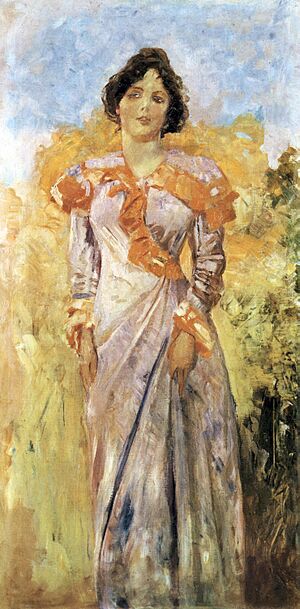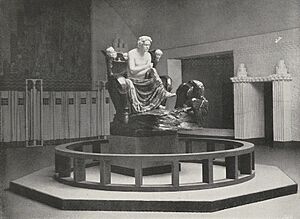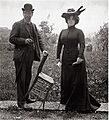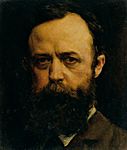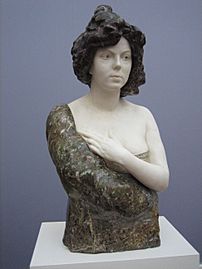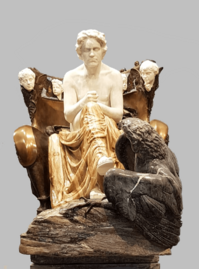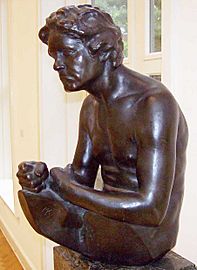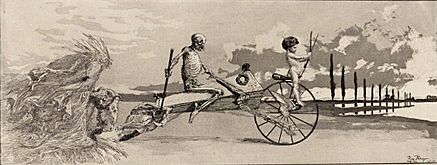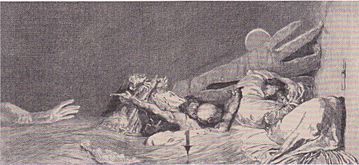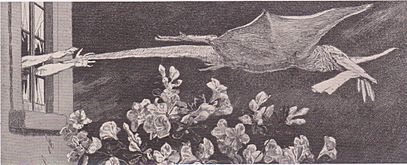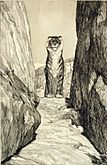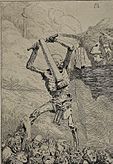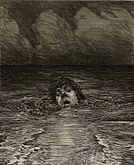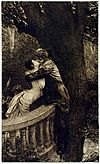Max Klinger facts for kids
Quick facts for kids
Max Klinger
|
|
|---|---|
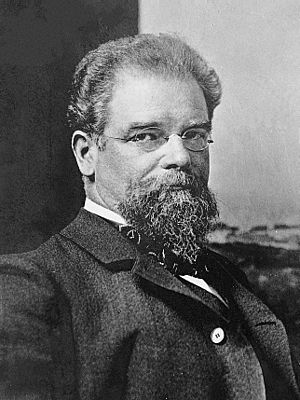 |
|
| Born | 18 February 1857 |
| Died | 5 July 1920 (aged 63) Naumburg, Germany
|
| Known for | Printmaking, painting, sculpture |
|
Notable work
|
Paraphrase über den Fund eines Handschuhs, Beethoven |
| Movement | Symbolism, Vienna Secession, Jugendstil, Art Nouveau. |
Max Klinger (born February 18, 1857 – died July 5, 1920) was a German artist. He created amazing works in painting, sculpture, and prints. He also wrote about his ideas on art.
Klinger is known for his connection to art styles like Symbolism and Art Nouveau. Today, he is most famous for his many prints. One well-known series is called Paraphrase on the Finding of a Glove. He is also known for his large sculpture honoring the composer Beethoven. This sculpture was shown at the Vienna Secession in 1902.
Contents
Max Klinger's Life Story
Klinger was born in Leipzig, Germany. His family was wealthy and well-known. In 1874, he started studying art at the Academy of Fine Arts in Karlsruhe. His teacher was Karl Gussow. When Gussow moved to Berlin, Klinger followed him to finish his studies there.
In Berlin, Klinger shared a studio with Christian Krohg. They both admired French writers who explored city life and society's hidden sides. At that time, realism was popular in Germany. Klinger felt a connection to artists like Arnold Böcklin. Klinger finished his studies in 1877.
He studied the etchings and prints of famous artists like Dürer, Rembrandt, and Goya. Klinger then learned engraving from Hermann Sagert. He quickly became a very skilled engraver himself.
Klinger traveled to Brussels in 1879 and Munich in 1880. He started to become famous for his drawings and prints. In 1881, he published two sets of etchings. One was Paraphrase on the Finding of a Glove. It was an instant hit and made him well-known.
From 1883 to 1887, Klinger lived in Paris. A poet and art critic named Jules Laforgue helped make his prints popular there. Around 1883, Klinger started sculpting. Sculpture became a big part of his work later in life. He began his famous Beethoven sculpture in Paris. But he didn't finish it until 1902.
In 1889, Klinger was invited to show his work in Brussels. He then moved to Rome, staying until 1893. In Rome, he studied old Italian art and ancient works. This time helped him understand anatomy and how to show mass and volume in his art. The 1890s saw Klinger focus more on sculpting than printmaking.
Klinger was a talented piano player. He was friends with the composer Max Reger. He also had a 20-year friendship with composer Johannes Brahms. This friendship led to Klinger's print series Brahms Fantasies (1894). Brahms even dedicated some of his music to Klinger.
In 1906, Klinger started the Villa Romana Prize. He bought a villa in Florence with a large park. Artists who won the prize could stay there for a few months. They could experience the city's culture. Famous artists like Käthe Kollwitz and Max Beckmann later received this prize.
Elsa Asenijeff (1867-1941) was a writer and poet. She was also Klinger's partner and muse for about 15 years. They had a daughter named Desirée Klinger (1900–1973). In 1903, Klinger moved from Leipzig. He bought a vineyard in Großjena, near Naumburg, Germany, where he lived later in life. In 1911, Klinger ended his relationship with Asenijeff. He later married Gertrud Bock (1893–1932) shortly before his death in 1920.
Max Klinger's Artworks
Klinger is well-known for his many series of intaglio prints. These prints greatly influenced other artists in the late 1800s and early 1900s. Klinger was skilled at combining different printmaking techniques. He used aquatint, drypoint, and etching on one plate. This created amazing textures and tones. His art covered topics from mysterious symbols to darker parts of real life. His series A Love (1887) was dedicated to Arnold Böcklin, another artist he admired.
The Glove Series
One of his most famous print series is Paraphrase on the Finding of a Glove (1881). The pictures were inspired by dreams Klinger had after finding a glove at an ice-skating rink. In this series, the glove becomes a symbol for the artist's romantic feelings. In each picture, the glove is in different dramatic situations. It acts like the person the artist loves.
Ideas on Art
In Paris, Klinger began writing his important book Painting and Drawing. It was published in 1891. In this book, Klinger argued that prints and graphic arts should have a new, important role in art. He believed they were different from painting. He also thought they were best for trying out new styles and ideas. Klinger also discussed the idea of Gesamtkunstwerk. This means an "all-embracing art form" where different arts like painting, sculpture, literature, and music work together.
Music in Art
Klinger loved music throughout his life. Musical ideas often appeared in his art. His print series were given opus numbers, just like musical works. His series Brahms Fantasies (1894) aimed to combine music, poetry, and visual art. It was meant to be seen while Brahms's music was played. This created a Gesamtkunstwerk. Klinger also made sculptures of famous composers like Beethoven, Brahms, and Liszt.
The Beethoven Sculpture
Klinger used many different materials in his sculptures. He was inspired by old statues made from colored stones. For his Beethoven sculpture, he used bronze, ivory, alabaster, and different marbles. He even traveled to select the alabaster and marbles himself. The process of making the large bronze throne for the sculpture was very complex.
The 14th exhibition of the Vienna Secession in 1902 was all about Beethoven. Max Klinger's Beethoven sculpture was the main artwork. The artists of the Secession created other works for the exhibition. The architect Josef Hoffmann helped design the whole display. Klinger's sculpture was placed in the main hall. Behind it was a mural by Alfred Roller. Gustav Klimt's famous Beethoven Frieze was in a nearby room. Even the shy composer Gustav Mahler helped by arranging music from Beethoven's Ninth Symphony for the opening.
This exhibition was like a modern art installation. It combined sculpture, paintings, and music. It received a lot of attention and caused some debate. While some critics disliked Klimt's murals, Klinger's sculpture also received mixed reviews.
Klinger's Influence
Many artists, like Giorgio de Chirico, saw Klinger as an important link. He connected the Symbolist movement of the 1800s to the start of the metaphysical art movement. Later artists like Max Ernst and other surrealist artists also admired his work. Klinger's prints influenced many artists. These include Franz von Stuck, Käthe Kollwitz, Edvard Munch, and Paul Klee.
Print Series by Max Klinger
- 1879. Radierte Skizzen (Etched Sketches), Opus I
- 1879. Rettungen Ovidischer Opper (Deliverances of Ovidian Victims) Opus II
- 1880. Eva und die Zukunft (Eva and the Future), Opus III
- 1880, Amor und Psyche (Cupid and Psyche), Opus V
- 1881. Intermezzi (Intermezzi), Opus IV
- 1881. Paraphrase über den Fund eines Handschuhs (Paraphrase on the Finding of a Glove), Opus VI
- 1883. Vier Landschaften (Four Landscapes), Opus VII
- 1883. Dramen (Dramas), Opus IX
- 1884. Ein Leben (A Life) Opus VIII
- 1887. Eine Liebe (A Love), Opus X
- 1889. Vom Tode, Erster Theil (On Death, Part One) Opus XI
- 1894. Brahmsphantasie (Brahms Fantasy), Opus XII
- 1898-1910. Vom Tode, Zweiter Theil (On Death, Part Two), Opus XIII
Klinger in Today's World
- In a play called Dämmerung by Elsa Bernstein, Klinger's etchings are mentioned.
- A Moscow art group created an art installation in 1991. It was called Klinger’s Boxes and was inspired by his Paraphrase on the Finding of a Glove.
- An Asteroid is named after him: 22369 Klinger.
Images for kids
Paintings
Sculptures
Drawings, Prints, and Graphics
See Also
 In Spanish: Max Klinger para niños
In Spanish: Max Klinger para niños


